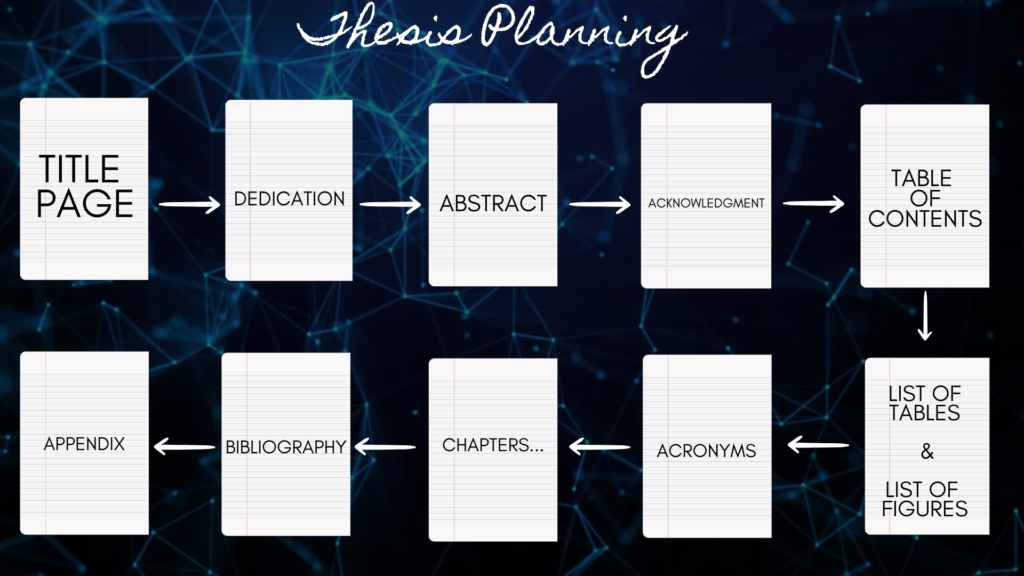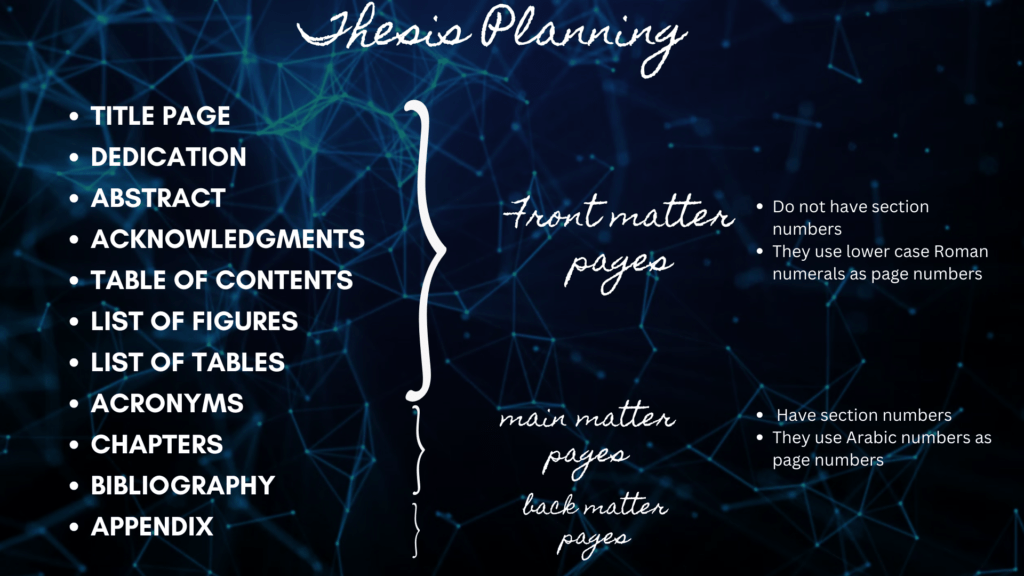For packages click the link below :
Click here for a free Overleaf Thesis template!
A Comprehensive Guide for STEM Scholars
Are you gearing up to write a thesis in the STEM field and wondering how to streamline the process effectively? Welcome to the world of LaTeX and Overleaf, your dynamic duo for crafting polished, professional, and meticulously structured academic documents. In this guide, we’ll delve into what LaTeX and Overleaf are, why they’re preferred for thesis writing, strategic planning tips for your thesis, the key sections and structure of a STEM thesis, and an exploration of front matter, main matter, and back matter pages.

What are LaTeX and Overleaf?
LaTeX is a typesetting system used for high-quality document preparation, especially in academic and technical writing. It’s renowned for its ability to handle complex structures like equations, figures, and citations with remarkable precision. Overleaf, on the other hand, is an online collaborative LaTeX editor that simplifies the writing process by providing a user-friendly interface, real-time collaboration, and cloud-based document storage.
Why Use LaTeX for Thesis Writing?
LaTeX offers unparalleled typographic quality, efficient handling of large documents, and seamless integration of mathematical equations and scientific notations. Its structured approach ensures consistency and professionalism throughout your thesis. Overleaf complements LaTeX by providing a collaborative platform accessible from anywhere, enabling multiple authors to work simultaneously, thus facilitating efficient teamwork.
How to Plan for Your Thesis?
Planning is the backbone of a successful thesis. Start by establishing a clear timeline and setting achievable milestones. Organize your research notes, references, and data systematically. Utilize tools like mind maps or outlining software to brainstorm ideas and structure your thoughts. Ensure you allocate ample time for drafting, revising, and proofreading your work.

Sections and Structure of a STEM Thesis
A typical STEM thesis follows a standard structure comprising distinct sections:
- Introduction: Sets the stage by outlining the research problem, objectives, and the significance of the study.
- Literature Review: Surveys existing literature relevant to your research topic, highlighting gaps your study aims to address.
- Methodology: Details the approach, techniques, and tools employed in conducting the research.
- Results: Presents the findings obtained from your research, often through data, tables, and figures.
- Discussion: Analyzes and interprets the results in the context of the research objectives, acknowledging limitations and suggesting future avenues.
- Conclusion: Summarizes the key findings and their implications, reinforcing the thesis’s significance.
Front Matter, Main Matter, and Back Matter Pages
Understanding these distinct parts of a thesis is crucial:
- Front Matter: Includes the title page, abstract, acknowledgments, table of contents, list of figures and tables, and any other preliminary information. These pages provide a comprehensive overview of the thesis.
- Main Matter: Comprises the main body of the thesis—Introduction, Literature Review, Methodology, Results, Discussion, and Conclusion—where the core content is presented.
- Back Matter: Contains supplementary materials like appendices, bibliography or references, glossary, and any additional materials supporting the main text.

Thesis Planning Tips
- Start Early: Begin your planning and research well in advance to allow ample time for revisions and unforeseen challenges.
- Set Realistic Goals: Break down your thesis into smaller, manageable tasks to maintain momentum and track progress effectively.
- Utilize Resources: Leverage academic resources, consult with advisors, and seek feedback regularly to refine your work.
- Stay Organized: Maintain a meticulous system for citations, references, and data organization from the outset to streamline the writing process.
In conclusion, writing a thesis using Overleaf and LaTeX can significantly enhance the quality, consistency, and efficiency of your academic document. By following a structured plan, understanding the thesis sections, and utilizing the front, main, and back matter effectively, you’ll be well-equipped to tackle the challenges of thesis writing in the STEM domain.
Remember, the journey of thesis writing is as much about the process as it is about the final product. Embrace the learning experience, stay persistent, and celebrate each milestone along the way.
Happy thesis writing!

